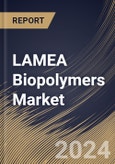The increasing recognition of the negative environmental effects of packaging materials and the pollution generated by plastic has boosted the demand for sustainable packaging alternatives. Biopolymers, being biodegradable and derived from renewable resources, are gaining popularity in the packaging industry. The trend is characterized by developing innovative bio-polymer-based packaging materials, including films, trays, and containers. Consumers seek eco-friendly alternatives, and companies are responding by incorporating these polymers into their product lines. This trend is driving market demand and influencing purchasing decisions across various industries.
One significant innovation involves sourcing biopolymers from non-food biomass feedstocks, such as agricultural and forestry residues. This strategy contributes to the sustainability of sources of these polymers feedstock by addressing issues with the competition between the production of bio-based materials and food. Precision fermentation techniques and synthetic biology are employed to produce more efficient polymers. Nanocomposites, which combine these polymers with nanoscale additives, are being developed to enhance material properties. These nanocomposites can exhibit improved strength, barrier properties, and flame resistance, opening new possibilities for the applications in electronics and construction.
They can be used to manufacture bio-based planting pots and trays in UAE. These sustainable alternatives can replace traditional plastic pots, offering a biodegradable option for nurseries and agricultural practices in the UAE. These polymers enhance water retention, improve soil structure, and reduce the need for excessive irrigation. This supports water conservation efforts in the arid climate of the UAE. Bio-based seed coatings contribute to sustainable agriculture in the UAE by reducing the need for chemical treatments and promoting healthier plant growth. Therefore, due to these aspects, the market will expand across the LAMEA region in upcoming years.
The Brazil market dominated the LAMEA Biopolymers Market by Country in 2022, and would continue to be a dominant market till 2030; thereby, achieving a market value of $771.8 million by 2030. The Argentina market is showcasing a CAGR of 12.9% during (2023 - 2030). Additionally, The UAE market would register a CAGR of 11.2% during (2023 - 2030).
Based on End-use, the market is segmented into Packaging, Consumer Goods, Automotive, Agriculture, and Textiles & Others. Based on Application, the market is segmented into Bottle, Films, Fibers, Seed Coating, Medical Implants, Vehicle Components, and Others. Based on Product, the market is segmented into Biodegradable Polyesters, Bio-PE, Bio-PET, Polylactic Acid (PLA), Polyhydroxyalkanoate (PHA), and Others. Based on countries, the market is segmented into Brazil, Argentina, UAE, Saudi Arabia, South Africa, Nigeria, and Rest of LAMEA.
List of Key Companies Profiled
- BASF SE
- Archer Daniels Midland Company
- DuPont de Nemours, Inc.
- bio-tec Biologische Naturverpackungen GmbH & Co. KG
- Novamont S.p.A. (Versalis S.p.A.)
- BiologiQ, Inc.
- Ecovia Renewables Inc.
- BioPolymer GmbH & Co KG
- Solanyl Biopolymers Inc.
- Biopolymer Industries
Market Report Segmentation
By End-use (Volume, Kilo Tonnes, USD Billion, 2019-2030)- Packaging
- Consumer Goods
- Automotive
- Agriculture
- Textiles & Others
- Bottle
- Films
- Fibers
- Seed Coating
- Medical Implants
- Vehicle Components
- Others
- Biodegradable Polyesters
- Bio-PE
- Bio-PET
- Polylactic Acid (PLA)
- Polyhydroxyalkanoate (PHA)
- Others
- Brazil
- Argentina
- UAE
- Saudi Arabia
- South Africa
- Nigeria
- Rest of LAMEA
Table of Contents
Companies Mentioned
- BASF SE
- Archer Daniels Midland Company
- DuPont de Nemours, Inc.
- bio-tec Biologische Naturverpackungen GmbH & Co. KG
- Novamont S.p.A. (Versalis S.p.A.)
- BiologiQ, Inc.
- Ecovia Renewables Inc.
- BioPolymer GmbH & Co KG
- Solanyl Biopolymers Inc.
- Biopolymer Industries
Methodology

LOADING...








